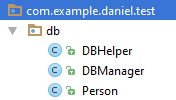SQLite开发实例
上一篇文章介绍了SQLite的一些基本用法,本篇文章是一个SQLite在项目中的实际例子。
实际开发中,为了能够更好的管理和维护数据库,我们会封装一个继承自SQLiteOpenHelper类的数据库操作类,然后以这个类为基础,再封装我们的业务逻辑方法。
目录结构
DBHelper继承了SQLiteOpenHelper,作为维护和管理数据库的基类,DBManager是建立在DBHelper之上,封装了常用的业务方法,Person是我们的person表对应的JavaBean.
DBHelper
package com.example.daniel.test.db;
import android.content.Context;
import android.database.sqlite.SQLiteDatabase;
import android.database.sqlite.SQLiteOpenHelper;
/**
* Created by Daniel on 10/12/2015.
*/
public class DBHelper extends SQLiteOpenHelper {
private static final String DATABASE_NAME = "test.db";
private static final int DATABASE_VERSION = 1;
public DBHelper(Context context) {
//CursorFactory设置为null,使用默认值
super(context, DATABASE_NAME, null, DATABASE_VERSION);
}
//数据库第一次被创建时onCreate会被调用
@Override
public void onCreate(SQLiteDatabase db) {
db.execSQL("CREATE TABLE IF NOT EXISTS person" +
"(_id INTEGER PRIMARY KEY AUTOINCREMENT, name VARCHAR, age INTEGER, info TEXT)");
}
//如果DATABASE_VERSION值被改为2,系统发现现有数据库版本不同,即会调用onUpgrade
@Override
public void onUpgrade(SQLiteDatabase db, int oldVersion, int newVersion) {
}
}
package com.example.daniel.test.db;
import android.content.ContentValues;
import android.content.Context;
import android.database.Cursor;
import android.database.sqlite.SQLiteDatabase;
import java.util.ArrayList;
import java.util.List;
/**
* Created by Daniel on 10/12/2015.
*/
public class DBManager {
private DBHelper helper;
private SQLiteDatabase db;
public DBManager(Context context) {
helper = new DBHelper(context);
//因为getWritableDatabase内部调用了mContext.openOrCreateDatabase(mName, 0, mFactory);
//所以要确保context已初始化,我们可以把实例化DBManager的步骤放在Activity的onCreate里
db = helper.getWritableDatabase();
}
/**
* add persons
*
* @param persons
*/
public void add(List<Person> persons) {
db.beginTransaction(); //开始事务
try {
for (Person person : persons) {
db.execSQL("INSERT INTO person VALUES(null, ?, ?, ?)", new Object[]{person.name, person.age, person.info});
}
db.setTransactionSuccessful(); //设置事务成功完成
} finally {
db.endTransaction(); //结束事务
}
}
/**
* update person's age
*
* @param person
*/
public void updateAge(Person person) {
ContentValues cv = new ContentValues();
cv.put("age", person.age);
db.update("person", cv, "name = ?", new String[]{person.name});
}
/**
* delete old person
*
* @param person
*/
public void deleteOldPerson(Person person) {
db.delete("person", "age >= ?", new String[]{String.valueOf(person.age)});
}
/**
* query all persons, return list
*
* @return List<Person>
*/
public List<Person> query() {
ArrayList<Person> persons = new ArrayList<Person>();
Cursor c = queryTheCursor();
while (c.moveToNext()) {
Person person = new Person();
person._id = c.getInt(c.getColumnIndex("_id"));
person.name = c.getString(c.getColumnIndex("name"));
person.age = c.getInt(c.getColumnIndex("age"));
person.info = c.getString(c.getColumnIndex("info"));
persons.add(person);
}
c.close();
return persons;
}
/**
* query all persons, return cursor
*
* @return Cursor
*/
public Cursor queryTheCursor() {
Cursor c = db.rawQuery("SELECT * FROM person", null);
return c;
}
/**
* close database
*/
public void closeDB() {
db.close();
}
}
package com.example.daniel.test.db;
/**
* Created by Daniel on 10/12/2015.
*/
public class Person {
public int _id;
public String name;
public int age;
public String info;
public Person() {
}
public Person(String name, int age, String info) {
this.name = name;
this.age = age;
this.info = info;
}
}
MainActivity
import java.util.ArrayList;
import java.util.HashMap;
import java.util.List;
import java.util.Map;
import android.app.Activity;
import android.database.Cursor;
import android.database.CursorWrapper;
import android.os.Bundle;
import android.view.View;
import android.widget.ListView;
import android.widget.SimpleAdapter;
import android.widget.SimpleCursorAdapter;
public class MainActivity extends Activity {
private DBManager mgr;
private ListView listView;
@Override
public void onCreate(Bundle savedInstanceState) {
super.onCreate(savedInstanceState);
setContentView(R.layout.main);
listView = (ListView) findViewById(R.id.listView);
//初始化DBManager
mgr = new DBManager(this);
}
@Override
protected void onDestroy() {
super.onDestroy();
//应用的最后一个Activity关闭时应释放DB
mgr.closeDB();
}
public void add(View view) {
ArrayList<Person> persons = new ArrayList<Person>();
Person person1 = new Person("Ella", 22, "lively girl");
Person person2 = new Person("Jenny", 22, "beautiful girl");
Person person3 = new Person("Jessica", 23, "sexy girl");
persons.add(person1);
persons.add(person2);
persons.add(person3);
mgr.add(persons);
}
public void update(View view) {
Person person = new Person();
person.name = "Jane";
person.age = 30;
mgr.updateAge(person);
}
public void delete(View view) {
Person person = new Person();
person.age = 30;
mgr.deleteOldPerson(person);
}
public void query(View view) {
List<Person> persons = mgr.query();
ArrayList<Map<String, String>> list = new ArrayList<Map<String, String>>();
for (Person person : persons) {
HashMap<String, String> map = new HashMap<String, String>();
map.put("name", person.name);
map.put("info", person.age + " years old, " + person.info);
list.add(map);
}
SimpleAdapter adapter = new SimpleAdapter(this, list, android.R.layout.simple_list_item_2,
new String[]{"name", "info"}, new int[]{android.R.id.text1, android.R.id.text2});
listView.setAdapter(adapter);
}
public void queryTheCursor(View view) {
Cursor c = mgr.queryTheCursor();
startManagingCursor(c); //托付给activity根据自己的生命周期去管理Cursor的生命周期
CursorWrapper cursorWrapper = new CursorWrapper(c) {
@Override
public String getString(int columnIndex) {
//将简介前加上年龄
if (getColumnName(columnIndex).equals("info")) {
int age = getInt(getColumnIndex("age"));
return age + " years old, " + super.getString(columnIndex);
}
return super.getString(columnIndex);
}
};
//确保查询结果中有"_id"列
SimpleCursorAdapter adapter = new SimpleCursorAdapter(this, android.R.layout.simple_list_item_2,
cursorWrapper, new String[]{"name", "info"}, new int[]{android.R.id.text1, android.R.id.text2});
ListView listView = (ListView) findViewById(R.id.listView);
listView.setAdapter(adapter);
}
}
注意的SimpleCursorAdapter的应用,当我们使用这个适配器时,我们必须先得到一个Cursor对象,这里面有几个问题:如何管理Cursor的生命周期,如果包装Cursor,Cursor结果集都需要注意什么。
如果手动去管理Cursor的话会非常的麻烦,还有一定的风险,处理不当的话运行期间就会出现异常,幸好Activity为我们提供了startManagingCursor(Cursor cursor)方法,它会根据Activity的生命周期去管理当前的Cursor对象
/**
* This method allows the activity to take care of managing the given
* {@link Cursor}'s lifecycle for you based on the activity's lifecycle.
* That is, when the activity is stopped it will automatically call
* {@link Cursor#deactivate} on the given Cursor, and when it is later restarted
* it will call {@link Cursor#requery} for you. When the activity is
* destroyed, all managed Cursors will be closed automatically.
*
* @param c The Cursor to be managed.
*
* @see #managedQuery(android.net.Uri , String[], String, String[], String)
* @see #stopManagingCursor
*/startManagingCursor方法会根据Activity的生命周期去管理当前的Cursor对象的生命周期,就是说当Activity停止时他会自动调用Cursor的deactivate方法,禁用游标,当Activity重新回到屏幕时它会调用Cursor的requery方法再次查询,当Activity摧毁时,被管理的Cursor都会自动关闭释放。
